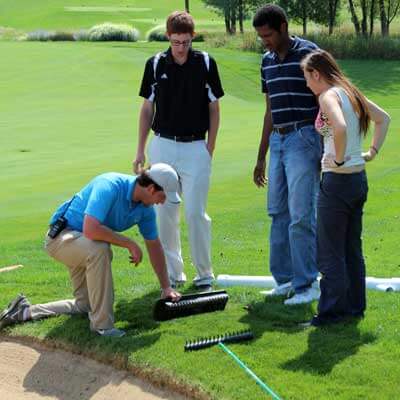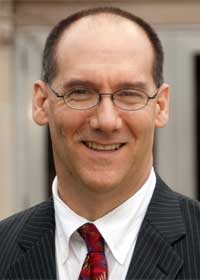 Two groups of NIU College of Engineering and Engineering Technology students partnered with Rich Harvest Farms as part of their senior design project.
Two groups of NIU College of Engineering and Engineering Technology students partnered with Rich Harvest Farms as part of their senior design project.
The task at hand: come up with a solution for the elite Sugar Grove golf course’s underground bunker rake system.
Rich Harvest Farms is one of the few golf courses that utilize this unique mechanism.
The rakes are stored in an underground compartment for a variety of reasons:
- First, for aesthetic and functionality purposes as the rake “pops up” nearly 30 inches from its compartment, making it easy for one to grab the rake and use it in the bunker.
- Second, because the system is underground, it also respects the USGA’s rules for keeping the rake outside (or inside for maintenance purposes) the bunker to reduce the overall chance of it coming into play by colliding with the ball.
Many courses have not accepted the system because it necessitates a caddie program – the idea being that most golfers would simply not take the time to put the rake back in its compartment, ultimately defeating its purpose. However, Rich Harvest Farms maintains a strong caddie program and so the underground rake system has worked well.
However, thanks to the elements and natural wear and tear, the mechanism recently developed several problems. “We were aware of the bunker mechanism problems, yet found a temporary solution,” said Jerry Rich, owner of the course.
Jerry and his wife, Betty Ann, who are both NIU alums, have supported and worked with the university for more than 50 years.
 Not only is Rich Harvest Farms the home course for the NIU men’s and women’s golf teams, but NIU students from a variety of colleges and departments have been involved in several on-site projects.
Not only is Rich Harvest Farms the home course for the NIU men’s and women’s golf teams, but NIU students from a variety of colleges and departments have been involved in several on-site projects.
These projects range from aiding in the design of bridges on the property, painting large scale decorative murals, and helping market major tournaments hosted on-site, such as the 2009 Solheim Cup – just to name a few.
“I have always enjoyed working with the university,” Rich said. “I wanted to once again engage NIU and challenge their engineering students to come up with their own ideas. I also feel it’s important for students today to get real-world experience, outside of the classroom.”
The goal of this project was for the students to develop a bunker rake system that would allow a golfer to eject the bunker rake from underground, and then replace the rake back into the ground with minimal effort.
The student design team experimented with a variety of alternatives to solve the problem and was challenged on several levels.
Not only did the students need to design the rake system itself, but also a housing system to protect the rake from the elements, as well as stay underground and protected from maintenance equipment such as mowers.
By the end of the project, the students had developed three different, yet equally fascinating prototypes.
“The students spent a lot of time looking at different ways of doing it,” said Cliff Mirman, chair of the Department of Technology and the faculty adviser for this project. “It was very complex because they had to keep sand and leaves out of the contraption, and water and cost were also an issue. They had to look at all different aspects of it and came up with a really cool design.”
Mirman’s student design team is wrapping up their prototypes this summer, but this fall will bring a new group of engineering students, under the direction of Shin-Min Song, who are also up for the challenge. This team includes mechanical engineering major and golf team member, Paul Hammerschmidt.
Because Hammerschmidt has plenty of experience teeing it up at Rich Harvest Farms, his approach to the bunker rake project should prove to be intriguing and exciting.
“Having a team member who plays Rich Harvest Farms gives the team the perspective of someone who knows how a golfer would prefer to use the rake system,” Hammerschmidt said. “It also allows our team to be aware of the weather conditions exerted on the rake system and the environment in which the rake system would reside.”

